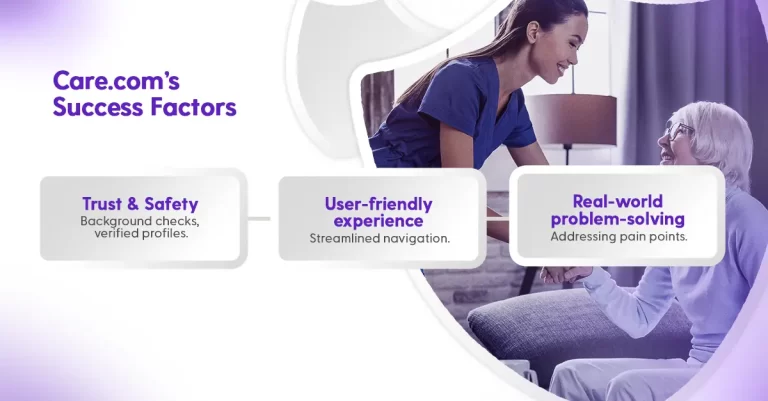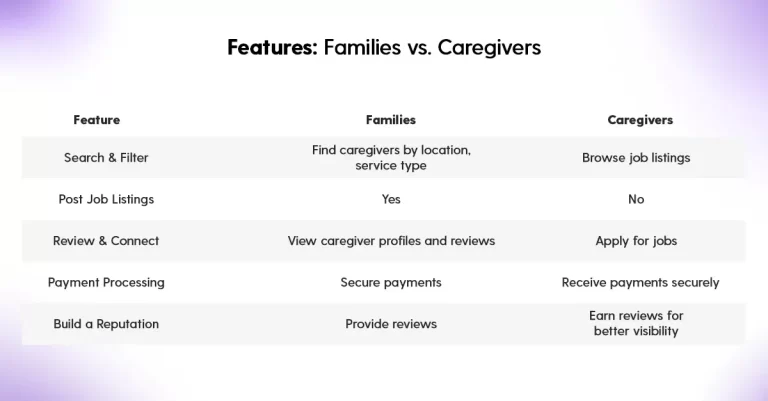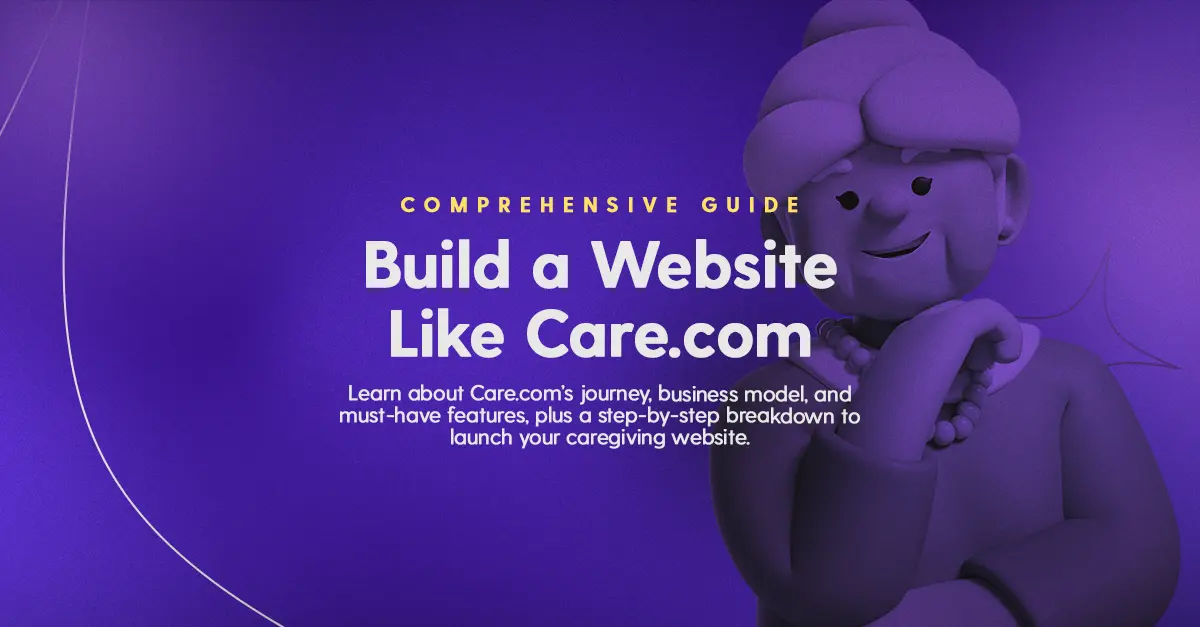Have you ever wondered what makes Care.com the leading caregiving platform in the world? In this guide, we’ll break down its success story, explore its business model, and provide you with a clear action plan to create your own caregiving marketplace.
Why trust us? At Dittofi, we’re empowered to build feature-rich, enterprise-grade marketplaces without the need for extensive coding. Our expertise in platform development ensures that you’ll gain actionable insights to avoid common pitfalls and build a marketplace that thrives.
Whether you’re focused on childcare, senior care, or even pet care, this guide will equip you with everything you need to turn your vision into reality.
What is Care.com?
Care.com is the go-to platform for families seeking reliable caregivers, whether for children, seniors, pets, or household tasks. Since its inception in 2007, it has become a global leader, boasting over 35 million members in more than 20 countries.
What makes Care.com so popular? It simplifies the daunting task of finding trustworthy care by offering a seamless platform where families and caregivers connect. Whether you’re a busy parent, a pet owner, or someone looking after elderly loved ones, Care.com takes the hassle out of the search.
But Care.com didn’t become the world’s largest caregiving marketplace overnight. Its success stems from solving real problems, prioritizing trust, and creating a user-friendly experience for everyone involved.
How Care.com Was Founded
Every great platform starts with a story. Care.com’s began when Sheila Lirio Marcelo, its founder, faced her own caregiving challenges. Balancing a demanding career with family life, Sheila realized how difficult it was to find reliable child care. This personal struggle planted the seed for Care.com.
Instead of diving headfirst into a fully-fledged platform, Sheila took a smart, calculated approach. She interviewed families and caregivers to uncover their biggest pain points, validating the concept before investing heavily. Armed with these insights, she launched a bare-bones version of Care.com in 2007.
Her goal? Build trust. Care.com prioritized safety features like background checks, verified profiles, and user reviews from day one, addressing families’ biggest concerns. This approach helped Care.com quickly gain traction, proving that solving real problems with simple, effective solutions is the key to success.

How Does Care.com Work?
Care.com operates as a two-sided marketplace, connecting families with caregivers. The platform makes it easy for both parties to find what they need, complete transactions, and build trust. Here’s how it works:
For Families:
- Search & Filter: Families can search for caregivers based on location, service type, availability, and hourly rate.
- Post Job Listings: They can post job descriptions outlining their caregiving needs.
- Review & Connect: Families can review caregiver profiles, ratings, and reviews before hiring.
- Payments: Secure payment processing ensures a smooth, worry-free transaction.
For Caregivers:
- Create a Profile: Caregivers can showcase their skills, experience, and certifications.
- Apply for Jobs: They can browse and apply to job listings that match their expertise.
- Get Paid: Payments are processed securely through the platform.
- Build a Reputation: Positive reviews help caregivers attract more clients.
The simplicity of Care.com’s model is its strength. By offering a streamlined user experience, it keeps both families and caregivers engaged while generating revenue through subscriptions and service fees.

How to Build a Marketplace for Caregivers Like Care.com
Creating a caregiving marketplace like Care.com might seem daunting, but breaking it into clear, actionable steps can make the process more manageable. Let’s dive deeper into how you can successfully launch your platform:
Launching a caregiving platform like Care.com requires thoughtful planning and a well-executed strategy. Here’s how you can break down the process and create a successful platform:
1. Start with In-Depth Market Research
Every great platform begins with understanding its users. Start by diving deep into the caregiving industry to uncover what families and caregivers truly need.
- Talk to Potential Users: Conduct surveys and one-on-one interviews with families and caregivers. What frustrates them about existing services? Is it a lack of trustworthy caregivers or limited availability during odd hours?
- Study the Competition: Analyze platforms like UrbanSitter, Sittercity, and TaskRabbit. Identify their strengths and weaknesses. Are their user interfaces intuitive? Do they offer robust filtering options for specific needs?
- Spot the Gaps: Look for untapped niches. For example, in some areas, there might be a growing demand for specialized caregivers for children with disabilities or multilingual caregivers for expat families.
By truly understanding your market, you’ll uncover opportunities to design a platform that solves real problems and stands out.
2. Define Your Unique Selling Point (USP)
In a competitive market, your platform needs a clear USP to differentiate itself from giants like Care.com. What can you offer that’s truly unique?
- Cater to a Specific Niche: Instead of targeting a broad audience, specialize in something underserved, like live-in elderly care or last-minute babysitting services. By being the go-to platform for a specific need, you’ll attract a dedicated user base.
- Emphasize Safety and Trust: Families value security, so offering more rigorous background checks and identity verification could give your platform an edge. Highlight these features prominently to build trust.
- Advanced Matching Features: Implement AI-driven algorithms to match families with caregivers based on experience, availability, and even personality traits. Personalized matching can significantly enhance the user experience.
Your USP is what will make users choose your platform over others, so focus on solving their biggest pain points with innovative solutions.
3. Develop a Minimum Viable Product (MVP)
Rather than building a fully-featured platform from day one, start small with an MVP to test the waters.
- Focus on Core Features: Your MVP should include the essentials: caregiver profiles, job postings, a messaging system, and secure payment processing.
- Streamline Onboarding: Ensure that families and caregivers can easily create accounts and navigate the platform. A clunky onboarding process will turn users away before they even try the service.
- Feedback Mechanisms: Include review and reporting tools so users can share their experiences. This will help you identify what’s working and where improvements are needed.
An MVP lets you test your concept with minimal investment, gather user feedback, and refine your platform before scaling.
4. Select the Right Tech Stack
Your platform’s technology will determine its performance, scalability, and user experience. Choosing the right tools is critical:
- Frontend Development: Use React.js or Next.js to build a sleek, responsive interface that works seamlessly across devices.
- Backend Development: Node.js with Express offers a fast, scalable foundation for handling user requests and processing data.
- Database Management: Opt for secure, efficient databases like PostgreSQL or MongoDB to store user profiles, job postings, and payment data.
- Payment Integration: Implement Stripe or PayPal to ensure smooth, secure transactions between families and caregivers.
- Hosting: Use cloud services like AWS or Vercel for reliable, high-speed hosting that can scale as your user base grows.
A robust tech stack ensures that your platform runs smoothly, even under heavy traffic, and provides users with a seamless experience.
5. Build and Test Your Platform
Once your MVP is ready, it’s time to bring your platform to life.
- User-Friendly Design: Prioritize clean layouts and intuitive navigation. Families should be able to quickly post jobs, and caregivers should find it easy to manage their profiles.
- Performance Testing: Test your platform under various conditions to ensure it performs well across devices and internet speeds. No one will stick around if pages take too long to load.
- Security Features: Protect user data with SSL encryption, secure authentication, and regular vulnerability testing. Building trust starts with robust security measures.
- Beta Launch: Release your platform to a small, select group of users. This allows you to gather valuable feedback and iron out any kinks before launching to the public.
Thorough testing ensures a polished product, minimizing user frustration and boosting retention rates.
6. Launch in a Targeted Niche Market
Rather than going national or global immediately, start small by targeting a specific niche or geographic area.
- Pick a High-Demand Location: Focus on cities or regions where caregiving services are in high demand but underrepresented.
- Specialize Your Offering: Start with a specific type of care, such as child care, senior care, or pet care, to attract a focused audience.
- Localized Marketing: Run targeted ads on social media platforms, partner with local community groups, and optimize your platform for location-based SEO.
By building a strong presence in one market, you can fine-tune your operations and gradually expand to other areas with confidence.

Transition to Growth: What Comes Next?
Once you’ve established a foothold in your niche market, gather user feedback to refine your platform. Gradually expand to new regions and offer additional services, scaling both your technology and operations.
Care.com Competitors: Understanding the Landscape
The caregiving marketplace is vast, and while Care.com has established itself as a leading platform, several competitors have carved out unique niches, offering specialized services to cater to different customer needs. Here’s a closer look at some of the top competitors and what sets them apart:
UrbanSitter: Babysitting with Real-Time Access
UrbanSitter is a go-to platform for families seeking babysitters and nannies. Its standout feature is real-time availability, allowing parents to book caregivers on short notice. The platform also integrates with social media, enabling families to find sitters recommended by friends or local community members. This focus on trust and immediacy has made UrbanSitter particularly appealing to busy parents juggling work and childcare.
Sittercity: Personalized Matching for Families
Sittercity differentiates itself with a personalized matching system. Families can post detailed job descriptions, and caregivers apply directly, offering a more tailored approach to finding the perfect fit. The platform also provides background checks, detailed caregiver profiles, and reviews, ensuring a high level of trust and security. Sittercity excels in creating long-term matches between families and caregivers, making it a strong competitor in the childcare space.
TaskRabbit: Versatility Beyond Caregiving
While TaskRabbit isn’t exclusively a caregiving platform, its broad range of household services includes caregiving tasks like elder care, pet sitting, and more. TaskRabbit’s appeal lies in its flexibility—users can book a “Tasker” for anything from assembling furniture to running errands, including light caregiving duties. This multi-service approach attracts users who prefer a one-stop shop for their household needs.
Helpling: Specialized in Housekeeping and Cleaning
Helpling is a platform primarily focused on cleaning and housekeeping services. However, its niche overlaps with Care.com in areas like home care and light caregiving duties. Helpling’s strength lies in its streamlined booking system and focus on quality assurance, which includes customer ratings and thorough vetting of service providers. For users seeking domestic help alongside caregiving, Helpling is a strong alternative.
Bambino: Babysitting with a Community Focus
Bambino is a newer competitor that leverages community connections to build trust. The platform allows families to find babysitters recommended by neighbors and local friends, fostering a sense of security. Its straightforward interface and emphasis on building local connections make it a rising competitor in the childcare sector.
CareLinx: Focused on Professional Care for Seniors
CareLinx specializes in senior care, offering services like in-home nursing, physical therapy, and companionship. The platform provides a unique care coordination feature that connects families with healthcare professionals. CareLinx stands out by addressing the specific needs of elderly clients, making it a top competitor in the senior caregiving niche.

Key Takeaways for Building a Competitive Platform
Understanding your competitors is essential for identifying gaps and opportunities in the caregiving marketplace. Here’s how you can stand out:
- Specialize in a Niche: Whether it’s senior care, babysitting, or housekeeping, focusing on a specific market segment can help you attract a dedicated user base.
- Enhance User Experience: Features like real-time booking, personalized matching, and community-driven trust systems can make your platform more appealing.
- Prioritize Security and Trust: Offering background checks, verified reviews, and secure payment systems can set your platform apart in a market where safety is paramount.
By studying these competitors and understanding their strengths and weaknesses, you can design a platform that not only meets market demands but also offers a unique value proposition that keeps users coming back.
Conclusion: Build Your Caregiving Platform Today
The demand for caregiving services is growing, and the success of Care.com proves there’s plenty of room for new platforms in this space. Whether you’re focused on childcare, senior care, or pet sitting, now’s the time to act.
By following the steps outlined in this guide, you’ll have everything you need to build a caregiving marketplace that attracts users, generates revenue, and stands out from the competition.
Ready to create your own Care.com? Let’s make it happen!
If you’re ready to create a platform that connects renters with car owners, now’s the perfect time to get started. With the rise of peer-to-peer car rentals, you can build a highly scalable, profitable business in a fast-growing market.
By following the steps in this guide, you’ll have everything you need to launch a successful platform. Whether you hire developers or use a no-code platform, your car rental business can be up and running in months.
Ready to build your own car rental platform? Let’s do it!
Ready to Build a Marketplace Like Care.com?
Transform your caregiving marketplace vision into reality with Dittofi. Build your platform faster, smarter, and with complete control over your features and code.

